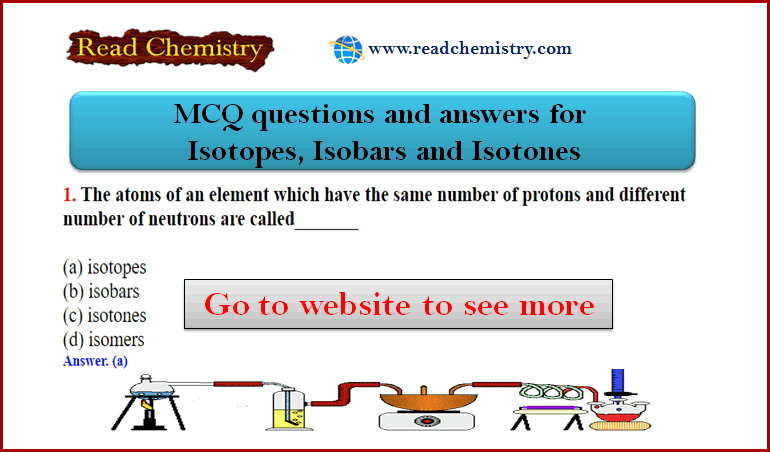MCQ on: Isotopes, Isobars, and Isotones
MCQ on: Isotopes, Isobars, and Isotones
– In this subject, you will find 25 questions and answers MCQ on Isotopes, Isobars, and Isotones.
1. The atoms of an element that have the same number of protons and different numbers of neutrons are called_______
(a) isotopes
(b) isobars
(c) isotones
(d) isomers
Answer. (a)
2. Isotopes of an element have _______ atomic number but _______ mass numbers.
(a) same, same
(b) different, same
(c) same, different
(d) different, different
Answer. (c)
3. _____occupy the same place in the periodic table.
(a) isobars
(b) isotopes
(c) isotones
(d) none of these
Answer. (b)
4. Isotopes have _______ chemical properties.
(a) same
(b) similar
(c) different
(d) none of these
Answer. (b)
5. The electronic configuration of isotopes of an element is _______.
(a) same
(b) similar
(c) different
(d) none of these
Answer. (a)
6. The physical properties of the isotopes which depend on the _______ of the atoms are used to separate them.
(a) electronic configuration
(b) mass
(c) velocity
(d) valence electrons
Answer. (b)
7. The mass number A is given by _______ (Z is atomic number and N is number of neutrons)
(a) A = Z – N
(b) A = Z + N
(c) A = N – Z
(d) A = 2 (Z + N)
Answer. (b)
8. An atom of _______ contains no neutrons.
(a) hydrogen
(b) deuterium
(c) tritium
(d) none of these
Answer. (a)
9. The difference between the number of neutrons and the protons is positive for _______
(a) hydrogen atom
(b) deuterium atom
(c) tritium atom
(d) none of these
Answer. (c)
10. An element with the atomic number equal to one, exists in three isotopes namely 1H1 , 2H1 and 3H1. Which of these has only one electron in its outermost shell?
(a) 1H1
(b) 2H1
(c) 3H1
(d) all the three
Answer. (d)
11. In which isotope of oxygen out of O16, O17, and O18 there are the equal number of protons, electrons, and neutrons?
(a) O16
(b) O17
(c) O18
(d) none of these
Answer. (a)
12. Which isotope of chlorine out of 35Cl17 and 37Cl17 has a greater number of neutrons than the protons?
(a) 17Cl35
(b) 17Cl37
(c) neither of the two
(d) both
Answer. (d)
13. The reaction rates of the individual isotopes are______
(a) the same
(b) different
(c) sometimes the same, sometimes different
(d) none of these
Answer. (b)
14. The atoms that have the same mass number but different atomic numbers are called_______
(a) isobars
(b) isotopes
(c) isotones
(d) isomers
Answer. (a)
15. Which is true about the isobars?
(a) they have the same mass number and same atomic number
(b) they have the same mass number and different atomic number
(c) they have different mass numbers and same atomic number
(d) they have different mass numbers and different atomic number
Answer. (b)
16. Which of the following statements holds good for 40Ar18 , 40K19 and 40Ca20 ?
(a) they have equal number of protons and electrons
(b) they have equal number of protons and neutrons taken together
(c) they have equal number of neutrons in their respective nuclei
(d) none of the above
Answer. (b)
17. Atoms that have different atomic numbers, and different mass numbers but the same number of neutrons are called _______
(a) isotopes
(b) isobars
(c) isotones
(d) isomers
Answer. (c)
18. Which of the following statement is true for 14C6, 15 N7 and 16O8 ?
(a) they have equal number of protons
(b) they have equal number of electrons
(c) they have equal number of neutrons
(d) they have equal mass number
Answer. (c)
19. Which of the following pairs represents isotones?
(a) 1H1 and 2H1
(b) 40Ar18 and 40K19
(c) 14C6 and 16O8
(d) 22Ne10 and 23Na11
Answer. (c)
20. Which of the following pairs represents isobars?
(a) 17O8 and 16O8
(b) 40K19 and 40Ca20
(c) 15N7 and 16O8
(d) 235U92 and 238U92
Answer. (b)
21. An isotone of 14C6is _______
(a) 16O8
(b) 13C6
(c) 17O8
(d) 16N7
Answer. (a)
22. Which of the following is isoelectronic with Cl–1?
(a) S2–
(b) P3–
(c) K+
(d) All
Answer. (d)
23. Two nuclei A and B are isotonic with mass numbers 15 and 16 respectively. If A contains 7 protons, then the number of protons in B would be _______
(a) 7
(b) 8
(c) 9
(d) 10
Answer. (b)
24.76Ge32 is isotonic with _______
(a) 77 Ge32
(b) 78As 33
(c) 78 Ge32
(d) 77 As33
Answer. (d)
25. Which of the following atoms contains the largest number of neutrons?
(a) 210Bi 83
(b) 208Bi 83
(c) 209 Pb84
(d) 208Pb84
Answer. (a)
Reference: Essentials of Physical Chemistry /Arun Bahl, B.S Bahl and G.D. Tuli / multicolor edition.








Very good
very very very nice